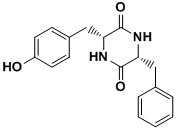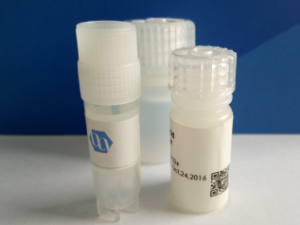$ 660.0
Quantity:50mg
In stock
Description
Product name: cyclo(D-Tyr-D-Phe)
Catalog#: 1304002
Synonyms: (3R,6R)-3-benzyl-6-(4-hydroxybenzyl)piperazine-2,5-dione,
Sequence: cyclo(D-Tyr-D-Phe)
Modifications: diketopiperazine(DKP),
M.W: 310.35
M.F.: C18H18N2O3
Purity: 95% by HPLC
Counter ion: Trifluoacetate
Format: Lyophilized powder
Description: A new microbial cyclic dipeptide (diketopiperazine), cyclo(D-Tyr-D-Phe) was isolated for the first time from the ethyl acetate extract of fermented modified nutrient broth of Bacillus sp. N strain associated with rhabditid Entomopathogenic nematode. Antibacterial activity of the compound was determined by minimum inhibitory concentration and agar disc diffusion method against medically important bacteria and the compound recorded significant antibacterial against test bacteria. Highest activity was recorded against Staphylococcus epidermis (1 µg/ml) followed by Proteus mirabilis (2 µg/ml). The activity of cyclo(D-Tyr-D-Phe) against S. epidermis is better than chloramphenicol, the standard antibiotics. Cyclo(D-Tyr-D-Phe) recorded significant antitumor activity against A549 cells (IC50 value: 10 μM) and this compound recorded no cytotoxicity against factor signaling normal fibroblast cells up to 100 μM. Cyclo(D-Tyr-D-Phe) induced significant morphological changes and DNA fragmentation associated with apoptosis in A549 cells. Acridine orange/ethidium bromide stained cells indicated apoptosis induction by cyclo(D-Tyr-D-Phe). Flow cytometry analysis showed that the cyclo(D-Tyr-D-Phe) did not induce cell cycle arrest. Effector molecule of apoptosis such as caspase-3 was found activated in treated cells, suggesting apoptosis as the main mode of cell death. Antioxidant activity was evaluated by free radical scavenging and reducing power activity, and the compound recorded significant antioxidant activity. The free radical scavenging activity of cyclo(D-Tyr-D-Phe) is almost equal to that of butylated hydroxyanisole, the standard antioxidant agent. We also compared the biological activity of natural cyclo(D-Tyr-D-Phe) with synthetic cyclo(D-Tyr-D-Phe) and cyclo(L-Tyr-L-Phe). Natural and synthetic cyclo(D-Tyr-D-Phe) recorded similar pattern of activity. Although synthetic cyclo(L-Tyr-L-Phe) recorded lower activity. But in the case of reducing power activity, synthetic cyclo(L-Tyr-L-Phe) recorded significant activity than natural and synthetic cyclo(D-Tyr-D-Phe). The results of the present study reveals that cyclo(D-Tyr-D-Phe) is more bioactive than cyclo(L-Tyr-L-Phe). To the best of our knowledge, this is the first time that cyclo(D-Tyr-D-Phe) has been isolated from microbial natural source and also the antibacterial, anticancer, and antioxidant activity of cyclo(D-Tyr-D-Phe) is also reported for the first time.
Usage: For Scientific Research Use Only, Not for Human Use.

